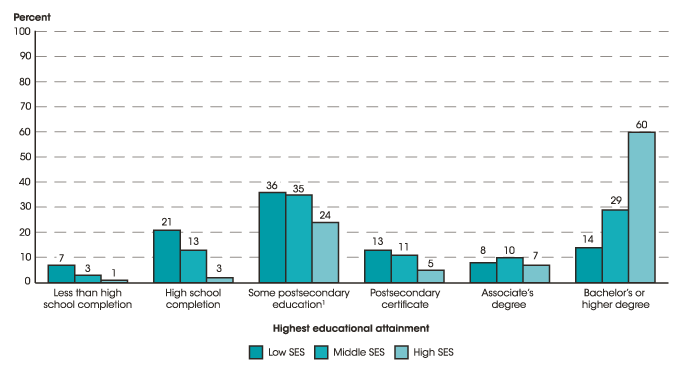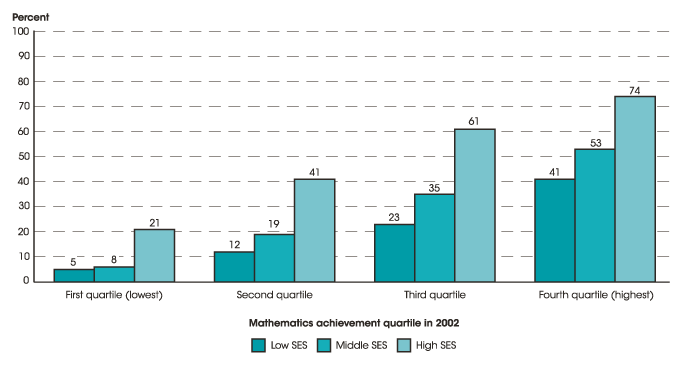By Lauren Musu-Gillette
Obtaining higher education can be an important step towards better occupational and economic outcomes. Lower levels of educational attainment are associated with higher unemployment rates and lower earnings. Although an increasing number of students have enrolled in postsecondary institutions over the last several decades, there are still differences in the characteristics of students who complete various levels of postsecondary education.
One particularly important issue to explore is differences in educational attainment by socioeconomic status (SES) to investigate the opportunities for social mobility that education can provide. Recently, NCES published a spotlight indicator on this topic to be included in the annual Condition of Education report. The report uses data from the Education Longitudinal Study of 2002 (ELS:2002), which surveyed students at different points during their secondary and postsecondary years. Students were first surveyed in 2002 when they were sophomores in high school. Then, their highest level of education was assessed ten years later, in 2012.
Percentage distribution of highest level of educational attainment of spring 2002 high school sophomores in 2012, by socioeconomic status (SES)

1 Includes education at any type of postsecondary institution, but with no earned postsecondary credential.
SOURCE: U.S. Department of Education, National Center for Education Statistics, Education Longitudinal Study of 2002 (ELS:2002). See Digest of Education Statistics 2014, table 104.91.
Several key findings highlight differences in educational attainment by SES. For example:
- Seven percent of low-SES students had not completed high school by 2012, greater than the percentages of middle- and high-SES students who had not completed high school by 2012;
- By 2012, Fourteen percent of low-SES students who were high school sophomores in 2002 had earned a bachelor’s or higher degree, smaller than 29 percent of middle-SES students and 60 percent of high-SES students who earned a bachelor’s or higher degree; and
- Compared to high-SES students, smaller percentages of low- and middle-SES students who performed in the highest quartile of math achievement during their sophomore year of high school went on to complete a bachelor’s degree by 2012.
Percentage of spring 2002 high school sophomores who earned a bachelor's degree or higher by 2012, by socioeconomic status (SES) and mathematics achievement quartile in 2002

SOURCE: U.S. Department of Education, National Center for Education Statistics, Education Longitudinal Study of 2002 (ELS:2002). See Digest of Education Statistics 2014, table 104.91.
The following video describes additional findings from the report:
By Elise Christopher and Lauren Musu-Gillette
Researchers, educators, and policy makers are interested in knowing what makes students ready for college and careers, and the Department of Education has identified college and career readiness as a priority. In 2011, the Department announced that it would allow for Elementary/Secondary Education Act (ESEA) flexibility for states that developed plans for reforms in certain key areas of education, including college and career readiness. In order to investigate what factors may be associated with college and career outcomes, several important questions arise. For example:
- How do students’ high school experiences relate to whether or not they have to enroll in remedial courses in college?
- How do these same experiences relate to whether or not they successfully complete college?
- What high school and college experiences are associated with successful career choices?
Questions like these are best answered with longitudinal surveys, which track the paths of students as they transition from school to college and the work force. The longitudinal surveys conducted by NCES contain a wide variety of survey components that enable researchers to address policy-related topics across disciplines. Such longitudinal data can be expensive and time consuming to collect, particularly if they are nationally representative with sufficient sample sizes to analyze barriers faced by disadvantaged young adults. Building a sound statistical foundation for these important analyses is one of the key contributions NCES makes when producing datasets such as the Education Longitudinal Study of 2002 (ELS:2002) for the education and research community.
ELS:2002 began by collecting data from a nationally representative cohort of students who were in the 10th grade in 2002. Follow up surveys were collected from these same students in 2004, 2006, and 2012. Some students enrolled in postsecondary institutions after high school, while others entered the workforce. ELS:2002 can be used to examine the educational and occupational paths of students over time, as well as the different factors that are associated with those paths.
ELS:2002 collected a wide variety of information including students’ school experiences and activities, plans for the future, family circumstances, and beliefs about themselves. Many variables in the ELS:2002 dataset are available to the public with no restrictions. The data are easily accessible for individuals who may be interested in examining how a variety of different backgrounds and experiences may affect students’ college and career readiness. Some variables are not in the public datasets to ensure that identities of survey respondents are protected, but are available to researchers who apply for a restricted use license.
Use of datasets such as ELS:2002 can assist researchers, educators and policy makers in answering important questions about how to prepare our students for college and careers. For more information on accessing and using ELS:2002 data, please refer to information about available data, see our detailed selection of users manuals, or email the ELS:2002 staff.
By Lauren Musu-Gillette
It is important for all students to feel safe at their schools and on their campuses. As one way to gauge the safety of college campuses, the Jeanne Clery Disclosure of Campus Security Police and Campus Crime Statistics Act, known as the Clery Act, requires colleges participating in Title IV student financial aid programs to report certain data on campus crime. Since 1999, data on campus safety and security have been reported by institutions through the Campus Safety and Security Survey. Types of on-campus crime that institutions are required to report include: burglaries; forcible sex offenses; motor vehicle thefts; and aggravated assaults. Additionally, a 2008 amendment to the Clery Act requires institutions to report data on hate crime incidents on campus.
Overall, reports of crime on college campuses have decreased in recent years. In 2012, there were 29,500 criminal incidents against persons and property on campus at public and private 2-year and 4-year postsecondary institutions that were reported to police and security agencies, representing a 4 percent decrease from 2011. Looking at on-campus crime patterns over a longer period, the overall number of crimes reported between 2001 and 2012 decreased by 29 percent.
In terms of specific crimes, the number of on-campus crimes reported in 2012 was lower than in 2001 for every category except forcible sex offenses. The number of reported forcible sex crimes on campus increased from 2,200 in 2001 to 3,900 in 2012 (a 77 percent increase). More recently, the number of reported forcible sex crimes increased from 3,400 in 2011 to 3,900 in 2012 (a 15 percent increase). It is important to keep in mind that data are available only for reported crimes. Thus, the increase could reflect an actual increase in the number of forcible sex crimes, or an increase in the number of people who report the crime when it occurs.
Hate crime reports are relatively rare among the more than 4,700 campuses offering 2- and 4-year programs. In 2012, there were 791 reported hate crime incidents that occurred on the campuses of these public and private 2-year and 4-year institutions. For the three most common types of hate crimes reported in 2012 (vandalism, intimidation, and simple assault), the most frequent category of bias associated with these crimes was race, and the second most frequent was sexual orientation.
The video below presents some additional information about crime and safety on college campuses:
For more information, see Indicators of School Crime and Safety: 2014.